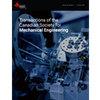刚度突变点节点应力校正在疲劳寿命评估中的研究与应用
IF 1
4区 工程技术
Q4 ENGINEERING, MECHANICAL
Transactions of The Canadian Society for Mechanical Engineering
Pub Date : 2023-05-16
DOI:10.1139/tcsme-2022-0163
引用次数: 0
摘要
本文提出了一种两级应力修正方法,以克服有限元分析中通常用于计算节点应力的单元应力平均法的局限性,提高大型结构刚度突变位置的疲劳寿命评估精度。在第一阶段,使用标准偏差加权应力平滑方法来解决刚度突变点处的高单元应力分散问题。第二阶段是基于节点应力受应力梯度路径上其他节点应力影响的理论建立的应力梯度校正方法。采用两级应力修正法提取了80吨吊舱车体关键点的节点应力,并结合大秦煤线的载荷谱对关键点的疲劳寿命进行了评估。将关键点处测得的应力谱对应的疲劳寿命与模拟值进行比较。与传统方法相比,该方法得到的关键节点疲劳寿命更接近实际疲劳寿命。此外,通过该方法获得的刚度突变位置的节点应力更准确。因此,两级应力修正方法是一个很有前途的大型结构疲劳寿命评估平台。本文章由计算机程序翻译,如有差异,请以英文原文为准。
Research and application of nodal stress correction at stiffness mutation position for fatigue life evaluation
This paper proposes a two-level stress correction method to overcome the limitations of the element stress average method that is typically used to calculate the nodal stress in finite element analyses and increase the fatigue life evaluation accuracy at the stiffness mutation positions of large-scale structure. In the first stage, a standard-deviation-weighted stress smoothing method is used to address the high element stress dispersion at the stiffness mutation point. The second stage involves a stress gradient correction method established based on the theory that the nodal stress is affected by other nodal stresses on the stress gradient path. The nodal stresses of the key points of an 80 tons gondola car body are extracted using the two-level stress correction method, and the fatigue life of the key points is evaluated considering the load spectrum of the Daqin coal line. The fatigue lives corresponding to the measured stress spectrum at the key points are compared with the simulated values. Compared with that obtained by the traditional method, the fatigue life of the key joints obtained by the proposed method is closer to the actual fatigue life. Additionally, the nodal stress at the stiffness mutation position obtained by the proposed method is more accurate. Therefore, the two-level stress correction method is a promising platform for the fatigue life evaluation of large-scale structures.
求助全文
通过发布文献求助,成功后即可免费获取论文全文。
去求助
来源期刊
CiteScore
2.30
自引率
0.00%
发文量
53
审稿时长
5 months
期刊介绍:
Published since 1972, Transactions of the Canadian Society for Mechanical Engineering is a quarterly journal that publishes comprehensive research articles and notes in the broad field of mechanical engineering. New advances in energy systems, biomechanics, engineering analysis and design, environmental engineering, materials technology, advanced manufacturing, mechatronics, MEMS, nanotechnology, thermo-fluids engineering, and transportation systems are featured.

 求助内容:
求助内容: 应助结果提醒方式:
应助结果提醒方式:


